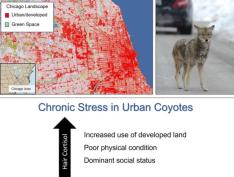
Given that coyotes are relatively large predators compared to most other urban wildlife, they face unique pressures such as crossing roadways to use suitable habitat fragments and are at a greater risk of being detected and experiencing negative human interactions. To assess whether urbanization influences hypothalamic-pituitary-adrenal axis activity in free-ranging coyotes, we analyzed cortisol concentration in hair samples from 97 coyotes residing across the urbanization gradient within the Greater Chicago Metropolitan area.
As the proportion of developed landcover within coyote home ranges increased, coyotes experienced more stress. Body condition and social status also had strong relationships with stress. Animals in poorer body condition experienced more stress and subordinate coyotes experienced less stress than alphas. We also found some evidence that stress varied seasonally and among different age classes. Understanding how intrinsic and extrinsic factors influence endocrine activity in urban carnivores is vital for predicting how hormone production and related behavioral patterns may change in future populations as more areas become developed.
Read in full in the journal.
